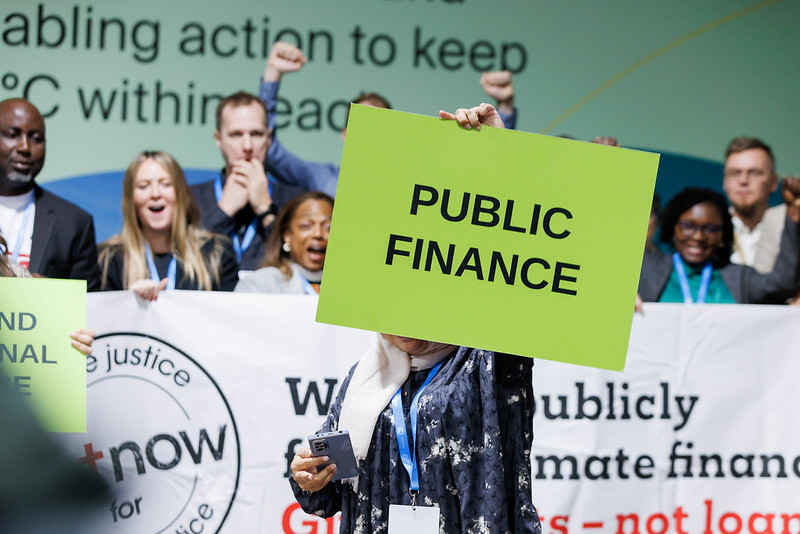Sandra Guzmán Luna is the founder and director-general of the Climate Finance Group of Latin America and the Caribbean (GFLAC).
World leaders, climate scientists, industry lobbyists and civil society actors are gathered in Baku, Azerbaijan for what’s being called the “Finance COP”. With negotiations around the so-called New Collective Quantified Goal (NCQG) set to take centre-stage, all eyes are on whether the international community can set a new target for climate finance that gives developing countries the support they need.
For regions such as Latin America and the Caribbean (LAC), a bold and ambitious NCQG is essential. According to the Climate Finance Group of Latin America and the Caribbean (GFLAC), an organisation that I founded and currently lead, the 20 major emitters in LAC currently receive 19 times more money from carbon-intensive activities than from climate and biodiversity finance. Ultimately, this is in no one’s interests, as Latin America’s carbon sinks and biodiversity are critical for the health of the entire planet.
Countries like Peru, Bolivia and Ecuador will not be able to transform their economies, protect nature, or deal with the escalating impacts of climate change, without much greater financial support from richer nations, who have done the most to cause the climate crisis. Indeed, this obligation is enshrined in the UN Framework Convention on Climate Change, agreed in 1992.
The last climate finance goal, for $100bn, agreed in 2009, was delivered two years late. There are different estimates around what is needed now – but all agree that the scale of required financing is in the trillions, not billions. Most developing nations estimate that between $1 trillion and $1.5 trillion a year at a minimum is needed to support efforts to address climate mitigation, adaptation and loss and damage by 2030.
Loans have worsened debt
The debate around the NCQG, however, is not just about quantity; the quality of the finance is also key. There were many lessons learned from the $100bn goal, but one of them was that too much of the money was in the form of loans, not grants, which exacerbated countries’ levels of already unsustainable debt. The goal was also not broken down into constituent parts for adaptation, mitigation and loss and damage, which is a key demand from developing nations this time around.
The truth for regions such as LAC is that we’ve been living with the harsh reality of climate change for some time. In May, the World Meteorological Organization (WMO) reported that the combination of El Niño and long-term climate change led in 2023 to drought, heat, wildfires, extreme rainfall and a record-breaking hurricane in LAC, all of which had “major impacts” on health, food and energy security and economic development.
The UN Population Fund also found that 41 million people – about 6% of the population across LAC – are exposed to threatening storms and flooding.
Adaptation Fund head laments “puzzling” lack of pledges at COP29
For regions like ours, it is absolutely critical that the NCQG delivers money for adaptation and loss and damage. For that to become a reality, we need to ensure that developing nations play a key role in the negotiations. We cannot afford to simply be passive bystanders.
We need a seat at the table to guarantee that the money made available is the right kind and can genuinely help us build resilience and respond to the economic losses already caused by climate change. Equally important is proper representation that can reflect the diversity of views among less developed nations. After all, the developing world is not homogenous.
More grants needed
Without the voices of low-income climate-vulnerable nations at the heart of NCQG discussions, we risk reaching an ineffective and fiscally wasteful settlement. The devastating 2022 floods in Pakistan, which affected 33 million people, provide a stark warning. As reported in the Financial Times, according to Pakistan’s economic affairs ministry, almost all of the $3bn provided “is in the form of dollar-denominated loans that were repurposed from pre-existing projects in Pakistan [adding to the] country’s mounting debt burdens”.
That underlines how important it is that we get this right. As developing nations dealing with the acute consequences of climate change and suffering under the burden of unpayable debt, we know what kind of financial support we need, and how it needs to be spent. That means more grants and less high-interest loans, and it means that public finance has to be at the core – we can’t rely on mobilising private money, especially for adaptation.
COP29 Bulletin Day 8: G20 backs new climate finance goal but offers no guidance
It’s imperative that those with decision-making power hear and trust our expertise, which is why COP29 presents such a fantastic opportunity. For the first time ever, there is a clear recognition that the NCQG negotiations must take into consideration the needs and priorities of developing countries. We now need to turn the rhetoric into action.
As climate-vulnerable nations, we need predictability and transparency. We need the confidence that the money is forthcoming so that we can plan accordingly, and the mechanisms in place to reassess if things aren’t moving in the right direction.
Anything less risks squandering hundreds of billions of dollars, and a further breakdown of trust between the developed and developed worlds, at a time of already fragile and fracturing multilateral consensus.
